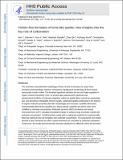| dc.contributor.author | Deymier, Alix C | |
| dc.contributor.author | Nair, Arun K | |
| dc.contributor.author | Depalle, Baptiste | |
| dc.contributor.author | Qin, Zhao | |
| dc.contributor.author | Arcot, Kashyap | |
| dc.contributor.author | Drouet, Christophe | |
| dc.contributor.author | Yoder, Claude H | |
| dc.contributor.author | Buehler, Markus J | |
| dc.contributor.author | Thomopoulos, Stavros | |
| dc.contributor.author | Genin, Guy M | |
| dc.contributor.author | Pasteris, Jill D | |
| dc.date.accessioned | 2021-10-27T20:28:52Z | |
| dc.date.available | 2021-10-27T20:28:52Z | |
| dc.date.issued | 2017 | |
| dc.identifier.uri | https://hdl.handle.net/1721.1/135702 | |
| dc.description.abstract | © 2017 Elsevier Ltd The nanometer-sized plate-like morphology of bone mineral is necessary for proper bone mechanics and physiology. However, mechanisms regulating the morphology of these mineral nanocrystals remain unclear. The dominant hypothesis attributes the size and shape regulation to organic-mineral interactions. Here, we present data supporting the hypothesis that physicochemical effects of carbonate integration within the apatite lattice control the morphology, size, and mechanics of bioapatite mineral crystals. Carbonated apatites synthesized in the absence of organic molecules presented plate-like morphologies and nanoscale crystallite dimensions. Experimentally-determined crystallite size, lattice spacing, solubility and atomic order were modified by carbonate concentration. Molecular dynamics (MD) simulations and density functional theory (DFT) calculations predicted changes in surface energy and elastic moduli with carbonate concentration. Combining these results with a scaling law predicted the experimentally observed scaling of size and energetics with carbonate concentration. The experiments and models describe a clear mechanism by which crystal dimensions are controlled by carbonate substitution. Furthermore, the results demonstrate that carbonate substitution is sufficient to drive the formation of bone-like crystallites. This new understanding points to pathways for biomimetic synthesis of novel, nanostructured biomaterials. | |
| dc.language.iso | en | |
| dc.publisher | Elsevier BV | |
| dc.relation.isversionof | 10.1016/J.BIOMATERIALS.2017.02.029 | |
| dc.rights | Creative Commons Attribution-NonCommercial-NoDerivs License | |
| dc.rights.uri | http://creativecommons.org/licenses/by-nc-nd/4.0/ | |
| dc.source | PMC | |
| dc.title | Protein-free formation of bone-like apatite: New insights into the key role of carbonation | |
| dc.type | Article | |
| dc.identifier.citation | Deymier, Alix C., et al. "Protein-Free Formation of Bone-Like Apatite: New Insights into the Key Role of Carbonation." Biomaterials 127 (2017): 75-88. | |
| dc.contributor.department | Massachusetts Institute of Technology. Department of Civil and Environmental Engineering | |
| dc.relation.journal | Biomaterials | |
| dc.eprint.version | Author's final manuscript | |
| dc.type.uri | http://purl.org/eprint/type/JournalArticle | |
| eprint.status | http://purl.org/eprint/status/PeerReviewed | |
| dc.date.updated | 2019-09-18T12:37:47Z | |
| dspace.orderedauthors | Deymier, AC; Nair, AK; Depalle, B; Qin, Z; Arcot, K; Drouet, C; Yoder, CH; Buehler, MJ; Thomopoulos, S; Genin, GM; Pasteris, JD | |
| dspace.date.submission | 2019-09-18T12:37:49Z | |
| mit.journal.volume | 127 | |
| mit.metadata.status | Authority Work and Publication Information Needed | |
